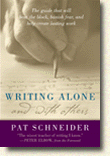|
 In
her introduction to Writing
Alone and With Others (Oxford University Press, 2003, pp.
xxiv-xx), Pat Schneider identifies the following key priorities for
the writer/artist: In
her introduction to Writing
Alone and With Others (Oxford University Press, 2003, pp.
xxiv-xx), Pat Schneider identifies the following key priorities for
the writer/artist:
. . . Whether your purpose is artistic expression, communication
with friends and family, the healing of an inner life, or achieving
public recognition for your art--the foundation is the same: the claiming
of yourself as an artist/writer and the strengthening of your writing
voice through practice, study, and helpful (as opposed to damaging)
communication with others.
Your task, as writer/artist, is to:
- Give yourself art/writing time.
- Sound more and more like yourself.
- Experiment, play, take risks, be brave.
- Believe in the freshness, vitality, and
importance of your own experience and imagination.
- Practice in ways that will teach you to
recognize your own voice and to increase its range (as a singer
learns to sing higher and lower--as a painter increases the number
of colors on a palette).
- Believe in yourself as an artist-in-training,
and protect yourself from everyone and everything that undermines
that belief.
- Observe.
- Remember.
- Imagine.
- Find and keep in contact with other writer/artists
who can provide you with an intimate community of support, give
you honest critical response, strengthen you, and encourage your
work.
Pat Schneider identifies five essential
affirmations and five essential practices that provide a welcoming and
trusting space for writers to nurture their artistry. Workshops and
writing groups that use the AWA method take these principles and practices
as their core (pp. ix-x):
The Five Essential Affirmations
- Everyone has a strong, unique voice.
- Everyone is born with creative genius.
- Writing as an art form belongs to all
people, regardless of economic class or educational level.
- The teaching of craft can be done without
damage to a writer's original voice or artistic self-esteem.
- A writer is someone who writes.
The Five Essential Practices
- A nonhierarchical spirit (how we treat
writing) in the workshop is maintained while at the same time an
appropriate discipline (how we interact as a group) keeps writers
safe.
- Confidentiality about what is written
in the workshop is maintained, and the privacy of the writer is
protected. All writing is treated as fiction unless the writer requests
that it be treated as autobiography. At all times writers are free
to refrain from reading their work aloud.
- Absolutely no criticism, suggestion, or
question is directed toward the writer in response to first-draft,
just-written work. A thorough critique is offered only when the
writer asks for it and distributes work in manuscript form. Critique
is balanced; there is as much affirmation as suggestion for change.
- The teaching of craft is taken seriously
and is conducted through exercises that invite experimentation and
growth as well as through response to manuscripts and in private
conferences.
- The leader writes along with the participants
and reads that work aloud at least once in each writing session.
This practice is absolutely necessary, for only in this way is there
equality of risk-taking and mutuality of trust.

Visit Amherst Writer's & Artists
|



